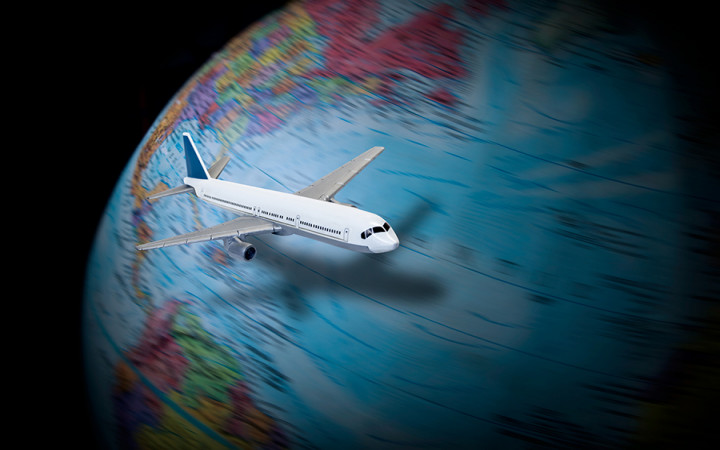Have you ever looked at a flight path on a map and wondered why airplanes take curved routes instead of flying in a straight line? Wouldn’t flying in a direct line be more fuel-efficient and faster? At first glance, it seems logical that a shorter distance would result in less fuel consumption, but in reality, aviation is far more complex.
Several factors determine flight paths, including the Earth’s shape, jet streams, weather conditions, and air traffic regulations. Let’s break down why airplanes rarely fly in a straight line and how their curved paths actually make flights more efficient.
The Earth’s Shape and the Great Circle Route

One of the biggest reasons airplanes don’t fly in a straight line is the Earth’s curvature. While we often view flight maps as flat, the Earth is a sphere, and the shortest path between two points is actually an arc called the Great Circle Route.
If you take a globe and use a string to connect two distant locations, you’ll notice that the shortest route often curves rather than follows a straight path. This is why flights from New York to Tokyo pass over the Arctic region rather than flying directly west across the Pacific Ocean.
Using the Great Circle Route helps planes save both time and fuel, even though it appears curved on a flat map.
Jet Streams and Weather Conditions Impact Flight Paths
Another key factor affecting airplane routes is jet streams—high-altitude wind currents that move at speeds of up to 200 mph (320 km/h). Pilots strategically plan routes to take advantage of these strong winds when possible.
Video : Why Airplanes Don’t Fly Straight
Flying with jet streams allows an airplane to get an extra push, helping it move faster while burning less fuel. Flying against a jet stream can slow down the plane significantly, increasing fuel consumption. Pilots often adjust routes to avoid strong headwinds, even if it means flying a longer distance.
Additionally, storms, turbulence, and severe weather conditions also play a role in determining flight paths. Airplanes may adjust mid-flight to bypass dangerous weather zones, thunderstorms, or areas with extreme turbulence.
Air Traffic Control and Flight Regulations
Air traffic isn’t a free-for-all where planes can just fly wherever they want. There are strict regulations set by aviation authorities and air traffic control (ATC) that dictate flight routes.
Some of these rules include restricted airspace, where certain areas, such as military zones, national security locations, and political zones, prohibit commercial flights from entering. Predefined flight corridors exist to avoid mid-air collisions, ensuring flights follow established air traffic lanes. Major airports handle hundreds of flights daily, so ATC ensures safe and efficient arrivals and departures.
Due to these regulations, airplanes cannot always take the most direct path and must follow designated routes instead.
Avoiding Air Turbulence for Passenger Comfort
Turbulence can make a flight uncomfortable, and pilots actively adjust routes to minimize rough air conditions. There are different types of turbulence, including thermal turbulence caused by warm air rising from the ground. Flying at higher altitudes helps avoid this.

Mechanical turbulence happens near mountains and rough terrains where wind patterns shift unpredictably. Clear-Air Turbulence (CAT) is sudden, strong air currents in high altitudes that are difficult to predict.
To ensure a smoother ride for passengers, pilots may deviate from the shortest path to avoid these turbulent areas.
Why Do Airplanes Sometimes Ascend Before Landing?
If you’ve ever been on a flight where the plane suddenly climbs just before landing, you might have felt a bit concerned. This maneuver is known as a go-around and is actually a common and safe aviation practice.
Some reasons why pilots perform a go-around include runway clearance issues. If another plane hasn’t cleared the runway in time, pilots must abort the landing and circle back. Poor weather conditions, such as poor visibility, strong crosswinds, or sudden gusts, can make a landing unsafe. If a plane is too fast, too high, or not properly aligned with the runway, the pilot will ascend and try again for a safer landing.
Go-arounds are standard procedures in aviation and ensure passenger safety above all else.
The World’s Longest Non-Stop Flight
While most flights follow curved paths, some routes push the limits of non-stop travel. The longest direct commercial flight in the world is from Singapore to Newark, New Jersey, USA.
This flight covers a distance of 10,400 miles (16,700 km) and takes approximately 18 hours and 45 minutes. It follows a carefully optimized path to balance fuel efficiency, wind conditions, and passenger comfort.
Video : Does Earth’s Rotation affect the Airplanes Speed & Flight Time
What Happens If a Plane Suddenly Loses Cabin Pressure?
A sudden drop in cabin pressure is often portrayed as a dramatic event in movies, but in reality, pilots are well-trained to handle it calmly.
When this happens, oxygen masks automatically deploy, and passengers should put them on immediately and breathe normally. The plane will descend to a safe altitude where oxygen levels are sufficient for breathing. The flight crew will assess the situation and communicate with passengers.
Losing cabin pressure doesn’t mean the plane will crash—pilots follow strict safety protocols to handle such incidents efficiently.
Final Thoughts: Why Curved Flight Paths Are More Efficient
While it may seem counterintuitive, airplanes take curved routes instead of straight lines to optimize flight efficiency, fuel usage, and passenger safety. Factors such as the Earth’s shape, jet streams, air traffic control, and weather conditions all play a crucial role in determining flight paths.
So next time you’re on a plane and see the route map displaying a curved flight path, remember there’s a lot of science and planning behind it to ensure you reach your destination as safely and efficiently as possible.
Minha filha perguntou à minha sogra: ‘O que você esconde na bolsa?’ — A verdade me quebrou

Quando minha filha de seis anos perguntou à avó o que ela estava escondendo na bolsa, pensei que fosse apenas uma pergunta boba. Mas então ela disse que a avó estava entrando furtivamente no meu quarto. O que encontrei dentro daquela bolsa desvendou tudo o que eu achava que sabia sobre meu casamento — e minha família.
Este ano já tinha sido pesado. James tinha aceitado aquela promoção chique seis meses atrás e vinha dividindo seu tempo entre cidades desde então. Ele ficava fora metade da semana, toda semana.

Uma mulher pensativa encostada no batente de uma porta | Fonte: Midjourney
Os ritmos do nosso casamento mudaram de maneiras para as quais eu não estava preparado.
“Vou ligar toda noite”, ele prometeu quando tudo começou. Mas as ligações logo viraram mensagens de texto, e as mensagens ficaram mais curtas.
Enquanto ele estava fora, eu fazia malabarismos com tudo sozinha. A casa, meu trabalho e Lily — nosso pequeno tornado de energia e perguntas.

Uma menina brincando em uma sala de estar | Fonte: Midjourney
Lily precisava de explicações para tudo, desde por que o céu é azul até por que os adultos às vezes choram quando estão sozinhos.
Então Carol, minha sogra, começou a aparecer mais vezes.
“Eu trouxe lasanha”, ela anunciou em uma tarde de terça-feira, parada em nossa varanda com um prato coberto de papel-alumínio. “James mencionou que você estava tendo uma semana difícil.”
Eu não tinha contado a James que estava tendo uma semana difícil. Mas eu peguei a lasanha, de qualquer forma.

Um prato de lasanha sobre uma mesa | Fonte: Pexels
Depois disso, ela vinha regularmente. Ela dobrava roupa enquanto eu cozinhava e lia para Lily enquanto eu colocava os e-mails de trabalho em dia. Às vezes, ela regava as plantas ou organizava uma gaveta da cozinha sem que eu pedisse.
“Você não precisa continuar vindo”, eu disse a ela um dia, embora parte de mim esperasse que ela não ouvisse.
“Bobagem”, disse Carol, empurrando o cabelo para trás da orelha. “O que mais eu faria? Assistir a programas de jogos o dia todo? Reduzi minhas horas na empresa justamente para poder passar mais tempo com minha família.”

Uma mulher em uma sala de estar sorrindo para alguém | Fonte: Midjourney
Sua voz era suave, mas firme — a voz que fez de James o homem com quem me casei.
Por semanas, acreditei que suas visitas eram um gesto atencioso, talvez até mesmo um lado positivo na crescente ausência de James. Alguém estava me vendo lutar. Alguém estava me ajudando.
Até ontem.
Eu estava carregando a máquina de lavar louça enquanto Carol tomava chá na ilha da cozinha.

Uma xícara de chá sobre uma mesa | Fonte: Pexels
Lily sentou-se ao lado da avó, desenhando imagens do que pareciam gatos roxos. A máquina de lavar louça zumbia. O relógio tiquetaqueava.
Então Lily levantou os olhos do desenho. “Mamãe, por que a vovó sempre pega coisas do seu quarto?”
Minhas mãos congelaram em um prato de jantar.

Uma mulher carregando pratos em uma máquina de lavar louça | Fonte: Pexels
“Que coisas, querida?”, perguntei, tentando soar casual.
Lily se virou para Carol. “O que você esconde na sua bolsa?”
Carol engasgou com o chá e tossiu forte.
A cozinha congelou em silêncio perfeito. Eu podia ouvir o zumbido da geladeira, de repente alto como um trovão.

Uma mulher na cozinha observando alguém | Fonte: Midjourney
“Lily, o que você quer dizer?”, perguntei, minha voz firme, embora meu coração não estivesse.
“Ela entra muito no seu quarto quando você não está lá em cima”, explicou Lily, ainda desenhando. “Ela pega alguma coisa e coloca na bolsa grande dela.”
A colher de Carol tilintou nervosamente contra sua xícara de chá quando ela a pousou. Foi um som baixo, mas naquele momento, foi tão alto quanto uma admissão.

Uma xícara de chá com uma colher dentro | Fonte: Pexels
O ar ficou elétrico.
“Carol?”, eu disse.
“Ela tem uma imaginação maravilhosa”, Carol disse com uma risada frágil. “Crianças, certo?”
Mas Lily não riu. “Eu vi você ontem. Você pegou a linda garrafa que cheira a flores.”

Uma garota com um olhar sério nos olhos | Fonte: Midjourney
Meu perfume. Aquele que James me deu no último Natal.
“Carol”, eu disse novamente, minha voz ficando mais baixa. “Abre.”
Ela apertou sua bolsa grande com mais força contra o seu lado. “Isso é ridículo. Eu não sei do que Lily está falando—”
“Abra”, repeti, agora mais bruscamente.

Uma bolsa sobre uma mesa | Fonte: Pexels
O ar entre nós estalou enquanto ela hesitava. Finalmente, com mãos trêmulas, ela desabotoou sua bolsa e a colocou no balcão.
“Lily, você pode ir brincar um pouco no seu quarto?”, perguntei, sem tirar os olhos de Carol.
“Mas eu ainda não terminei com meu—”
“Leve o desenho com você”, eu disse com firmeza.

Uma mulher tensa em pé com as mãos na cintura | Fonte: Midjourney
Quando Lily se foi, peguei a bolsa. Carol não fez nenhum movimento para me impedir. Conforme eu tirava os itens, cada um parecia um soco no meu estômago.
Meu colar de aniversário de dois anos atrás.
Os brincos de pérola que James me deu durante nosso fim de semana de noivado no Maine.
Dois frascos de perfume.

Um frasco de perfume sobre uma mesa | Fonte: Pexels
E então, no fundo, dobrado cuidadosamente, um pedaço de papel. Desdobrei-o e reconheci a letra de James imediatamente:
“Pegue tudo que eu dei a ela. Não quero que nada fique para trás quando eu for embora.”
Olhei para Carol. Sua expressão finalmente rachou, lágrimas enchendo seus olhos.
“Quanto tempo?” Minha voz soou estranha aos meus ouvidos.

Uma mulher em pé na cozinha com os braços cruzados | Fonte: Midjourney
“Desde abril”, ela sussurrou.
“Abril”, repeti. Quatro meses dela vindo à minha casa. Quatro meses ajudando com o jantar e dobrando roupa, enquanto sistematicamente apagava pedaços da minha vida.
“Eu sabia que era errado”, disse Carol, com a voz embargada. Ela soluçou baixinho, os ombros tremendo. “Ele disse que você choraria e o manipularia. Que ele se sentiria culpado. Então ele me pediu para… começar a aceitar as coisas. Para tornar mais fácil para ele.”

Uma mulher carrancuda | Fonte: Midjourney
“Mais fácil para ele”, repeti.
“Eu acho… eu acho que ele está saindo com outra pessoa”, ela continuou, torcendo a faca mais fundo. “Que ele está planejando deixar você por ela.”
Eu agarrei o balcão com tanta força que meus dedos ficaram brancos. Cada memória, cada presente, roubado, apagado pedaço por pedaço enquanto eu pensava que estava sendo apoiado.
“Quem é ela?” perguntei.

Uma mulher olhando fixamente para alguém | Fonte: Midjourney
“Alguém do novo escritório dele. Ele fica mencionando uma Ashley ou Amanda. Algo assim.” Carol enxugou os olhos.
Pensei em todas as noites em que ele não ligou, em todos os fins de semana em que ele chegou tarde em casa e no olhar distante em seus olhos quando eu falava sobre o nosso futuro.
“Ele é um covarde”, Carol disse de repente, sua voz endurecendo. “E um trapaceiro. Eu pensei que estava ajudando ele, mas eu só o ajudei a machucar você. Eu vejo isso agora”

Uma mulher de aparência severa | Fonte: Midjourney
Olhei para ela, surpreso com a mudança.
Carol endireitou os ombros, enxugando as lágrimas das bochechas. “Eu nunca deveria ter concordado com isso. Nunca.”
Pela primeira vez desde que a conheci, vi além do papel de sogra. Ela era uma mulher que tinha cometido um erro terrível, mas que não era desprovida de princípios.

Uma mulher olhando de soslaio para alguém | Fonte: Midjourney
“Eu sou advogada, lembra?” Ela disse firmemente. “E eu vou te ajudar. Ele trapaceou. Ele me manipulou para ajudá-lo. E você tem todo o direito à casa, à verdade. A tudo.”
Eu assenti lentamente, ainda processando.
“Ele sabe que você está me contando isso?” perguntei.
“Não”, Carol respondeu. “Ele acha que estou aqui apenas ajudando com Lily. Como sempre.”

Uma mulher com olhos expressivos | Fonte: Midjourney
Naquele momento, Carol e eu nos sentamos e bolamos um plano. Naquela noite, depois do jantar, depois de ler três histórias para Lily e colocá-la na cama, mandei uma mensagem para James:
“Venha para casa. Precisamos conversar.”
Sua resposta veio rápida: “Isso pode esperar até amanhã?”
“Não”, respondi.
Poucos minutos depois, ele respondeu: “Tudo bem. Consegui reservar um voo para hoje à noite. Chego lá em algumas horas.”

Uma mulher usando seu celular | Fonte: Pexels
Enquanto esperava, alinhei tudo na mesa da sala de jantar: as joias que ele me dera, fotos nossas, cartões que ele me escrevera. Uma história visual do que ele estava tentando apagar.
Quando ele chegou, pouco antes da meia-noite, sua expressão era casual, despreocupada. Ele pendurou o casaco na porta como em qualquer noite comum.
“O que é tão urgente?” ele perguntou, então congelou quando viu a mesa.

Um homem olhando para algo com os olhos arregalados | Fonte: Midjourney
“Você mandou sua mãe fazer o seu trabalho sujo”, eu disse calmamente.
Ele olhou para o display, depois para mim. “Ela te contou.”
“Não. Lily a viu pegando minhas coisas. Nossa filha pegou sua mãe roubando de mim porque você mandou.”
James deu de ombros, seu rosto endurecendo. “Você fica emotivo. Eu não queria um colapso.”

Um homem fingindo indiferença | Fonte: Midjourney
“Um colapso”, repeti. “É isso que você chama de descobrir que meu marido está me traindo e planejando ir embora?”
“Eu ia te contar—”
“Quando? Depois que sua mãe limpou todos os vestígios do nosso casamento desta casa?”
Do corredor veio outra voz. “Eu me faço a mesma pergunta.”

Um corredor de casa | Fonte: Pexels
Nós dois nos viramos. Carol ficou ali, de braços cruzados.
“Mãe”, disse James. “Você não deveria estar aqui.”
“Eu criei um filho que se esconde atrás da mãe para acabar com o casamento”, disse Carol, com a voz tremendo de raiva. “Estou envergonhada e estou aqui para consertar meus erros.”
O rosto de James ficou vermelho. “Você concordou em ajudar.”

Um homem furioso | Fonte: Midjourney
“Eu deveria saber melhor”, disse Carol, entrando na sala. Ela se virou para mim. “Ela é dona desses presentes por lei. E se você não lidar com essa separação respeitosamente, eu vou garantir que o tribunal saiba de tudo.”
“Você está do lado dela?”, perguntou James, incrédulo.
“Estou tomando o lado da decência”, Carol respondeu. “Algo que claramente falhei em lhe ensinar direito.”
James olhou de um para o outro, perdendo a compostura.

Um homem de aparência nervosa | Fonte: Midjourney
Sem dizer mais nada, ele pegou seu casaco e saiu furioso, batendo a porta atrás de si.
Carol ficou parada sem jeito perto da mesa de jantar. “Tenho tudo o que ele me mandou levar. Está no meu carro.”
“Obrigado”, eu disse.
“Eu sei que você provavelmente me odeia…” ela começou.

Uma mulher parecendo preocupada | Fonte: Midjourney
“Eu não odeio você”, interrompi. “Estou bravo e magoado. Mas você está aqui agora, dizendo a verdade.”
Ela assentiu, lágrimas nos olhos novamente. “O que você vai fazer?”
Olhei ao redor para a casa que parecia tão pesada por tanto tempo. Talvez não fosse a casa que estava pesada. Talvez fosse o casamento.
“Primeiro, preciso de um bom advogado”, eu disse.

Uma mulher com uma carranca preocupada | Fonte: Midjourney
Carol me deu um sorriso triste.
“Você já tem uma.” Ela tocou meu braço gentilmente. “Vamos recuperar sua vida.”
Eu assenti, sentindo-me cru, mas de alguma forma mais forte do que me senti em meses. Este pode ser o começo de me tornar inteiro novamente, não apesar do que tinha sido tirado, mas porque agora eu podia ver claramente o que precisava ser recuperado.
Quando meu marido anunciou presunçosamente que iria para um resort de férias sem mim porque eu “não trabalho”, sorri docemente e o deixei ir. Mas por trás daquele sorriso? Uma tempestade estava se formando. Ele pensou que eu não fiz nada o dia todo. Ele estava prestes a descobrir exatamente o quão errado ele estava.



Leave a Reply